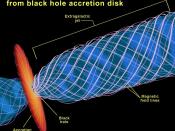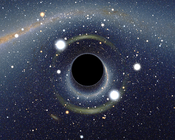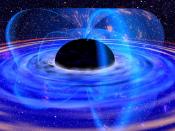Abstract
This paper examines a phenomenal event of space that astronomers commonly refer to as a black hole. Included is an explanation of what a black hole is and how it is believed they are created. The forceful effects a black hole imposes on surrounding celestial materials and the limits or boundaries of a black hole's force are studied. Finally a comparison of factual and fictional information about black holes is presented. Sources utilized for research data encapsulated in this paper are largely current articles and papers found on the World Wide Web as well as a student text book about Astronomy.
Black Holes
Humans have known of the existence of stars since they have had eyes and an interest to gander into the night sky. Although interpretations may have differed on what stars were, they were always thought of as white glowing specks in the sky. However the mystery does not lie within what one can see, but what one can not see.
There are billions of stars lighting the darkness of the universe, but the question lies in what happens when one of these enormous lamps burns out. Upon many speculations, one of the most fascinating fates of a star is the black hole theory.
What is a Black Hole?
Thought of as one of the most interesting phenomena in space, the theory of the black hole provides an explanation of what happens to very massive stars at the end of their life. The term "black hole" was coined by John Archibald in 1971 to describe these space events that seemingly let zero light escape from their grasp. The theory of the black hole has evolved from Einstein's generally accepted theory of relativity. Specifically based in theory, scientists are still uncertain as to whether black holes exist. However,



... ;-)
Well expained subject, not only for the professors from the university, but also for pupils. Good job!
0 out of 2 people found this comment useful.